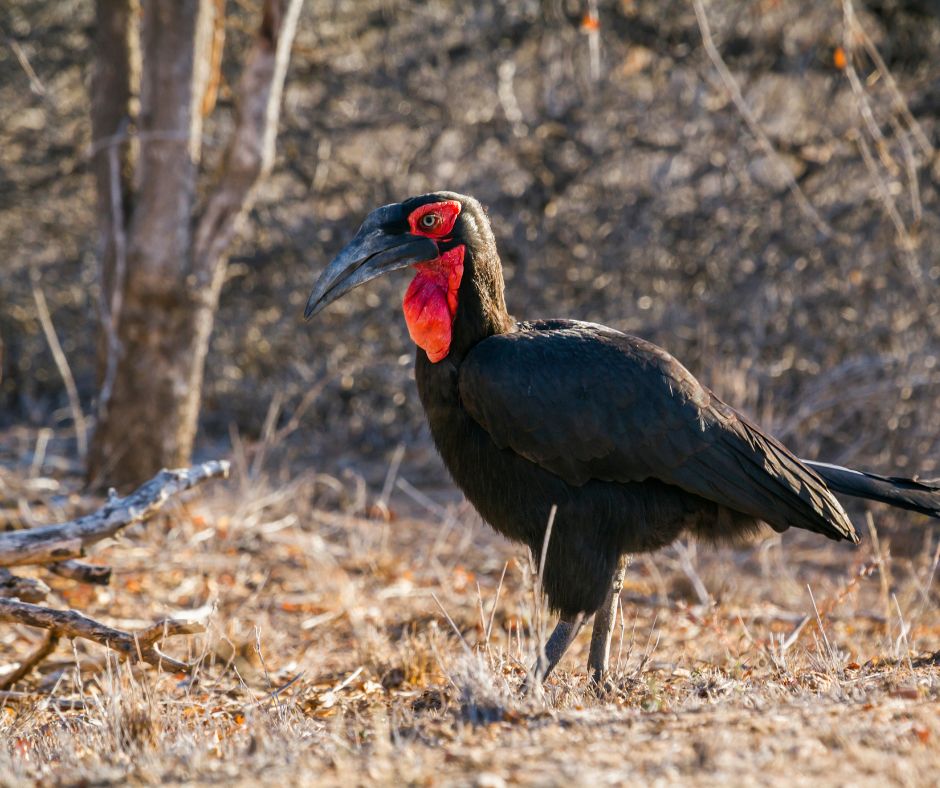Big Five of the Sky
The world of birds is absolutely fascinating, but initially, it can be tough telling your finches from your flycatchers. Begin your journey on less complicated ground by studying this list of easily identifiable birds and looking out for them on your next game drive.
Once you’re confident at identifying these beauties, you’ll be amazed by the way your knowledge organically expands and grows. Soon, you’ll be pulling our guides over for every little brown job (LBJ) that crosses your path!
The Birding Biggies
1. Lappet-faced vulture
Weighing in at around 7 kg, this bird of prey has a stark and commanding presence, although it might not be winning any beauty pageants in the near future. As you know, vultures are predominantly scavengers and the Lappet-faced vulture has developed a reputation as the “playground bully” because of its ferocious nature around a carcass during feeding time. It’s even been known to keep hyenas at bay!
You’ll see them take to the skies after sunrise, when the Earth has warmed up, allowing them to catch thermals into the air. Once up there, they roam in search of carrion (dead animals), identifying carcasses from 8 km away with their excellent eyesight.
They are easily identifiable by their bare pink head and the orange-tinted folds of skin that come with maturity.
Lappet-faced vultures are long-lived birds. In captivity, they’ve been known to reach 50 years of age, but in the wild, this number averages out at about 30 years.

2. Martial Eagle
Capable of knocking an adult man off his feet, the Martial eagle is the largest eagle on African soil. It weighs in at about 6,5 kg with a wingspan over 6 ft long! Identify it by its white belly, dark brown upperparts and white legs. True eagles have their legs covered in feathers all the way to their feet – a good tip to remember.
Luckily for us, Martial eagles don’t actually go about knocking men over for no reason. They prefer a diet of poultry, guineafowl, francolins and bustards, but have also been known to prey on hyrax, small antelopes, monkeys and even some carnivores like jackal and Serval cats. Their diet is dependent on where they live, and sometimes they take small domestic animals like goats and lambs.
They nest in tall trees up to 80 ft off the ground. Their nests are massive, basin-shaped structures measuring about six feet across and four feet thick.
Chicks will take their first flight at around 100 days old.

3. Saddle-billed stork
This large wading bird stands 150 cm tall and is predominantly black with a white upper body and a unique bill of red, yellow, and black. The base of its bill looks like a yellow saddle – hence the name.
Males and females can be differentiated by eye-colour. Males have dark down eyes, whereas females have yellow eyes.
You’ll find them by the water’s edge, foraging for small fish, frogs and insects alone or in pairs.

4. Kori bustard
Meet the largest flying bird in the world! (Heaviness-wise.) Weighing in at about 19 kg, you can imagine the effort it takes the Kori bustard to heave itself into the air. With that said, they are powerful flyers and seeing them take off is quite incredible. They don’t stay aloft for very long as this expends precious energy, and prefer to run from danger if they can get away with it.
In fact, the word “bustard” means “bird that walks” – what did you think it meant?
The Kori bustard is omnivorous, eating both plants and animals like lizards and snakes. Interestingly, the Kori bustard drinks using a sucking motion, unlike other birds who simply scoop water into their beaks.

5. Southern ground hornbill
The largest of the hornbill species weighs in at about 3,5 to 4 kg and measures between 90 and 110 cm in height.
Unlike the other hornbill species, the Southern ground hornbill does not seal the female into the nest during breeding season. (Ask your guide about this ritual!)
Southern ground hornbills spend 70% of their time on the ground foraging for food. They aren’t picky eaters and will consume anything from insects to reptiles or rodents and even amphibians.
These long-lived birds reach between 40 and 50 years of age and prefer grassland, savannah or woodland habitats. Southern ground hornbills are very slow to expand their population, with a 71% juvenile mortality rate. It’s estimated that after reaching maturity at eight years of age, a Southern ground hornbill breeding group will only fledge a chick successfully every six years.

The best time of year for birding in South Africa
Although there are always fascinating birds to see year-round at Leopard Hills, the Green Season (which falls between November and March) in our wet summer months is a particularly good time to come on birding safaris.
This is also mating season and the migratory birds will have returned to roost. You’ll spot plenty of flamboyant plumes and interesting mating displays between birds at this time of year.
Book your birding safari
If you’re interested in inquiring about birding safaris at Leopard Hills, please don’t hesitate to get in touch with our friendly reservations team directly at book@leopardhills.com or use our online booking system by clicking here.
We look forward to welcoming you to Leopard Hills in 2023!




